Cluster mushrooms, also known as cespitose mushrooms, grow from a common origin in tight clusters and belong to the kingdom of fungi. Not only are mushrooms delicious, but also they offer many health benefits including macronutrients to support healthy immune systems. Additionally, they contain selenium which provides antioxidant enzyme support to prevent cell damage.
Knowing the difference between edible and poisonous mushrooms is an important first step when foraging. In this article, we’ll discuss edible cluster mushrooms, their origins, health benefits, and how to use them.
Maitake Mushrooms or Hen of the Woods (Grifola frondose)
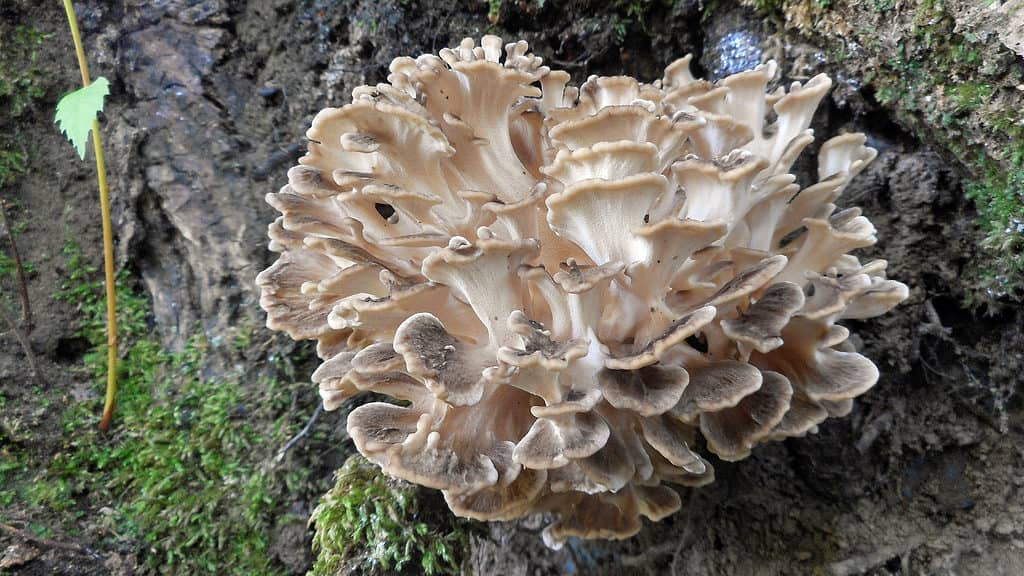
Maitake mushrooms grow in circular clusters in shelf-like formations.
©Lorenzo Martinelli/Shutterstock.com
Although enjoyed for their taste, they are also a medicinal mushroom. Their many healing properties aid the body in fighting physical and mental issues. Maitake comes from the Japanese word for “dancing.”
Where are They Found and How are They Identified?
They thrive during autumn months in North America, China, and Japan at the base of maple, elm, and oak trees in shelf-like clusters. In fact, they look like the tail feathers of a hen, hence the name “hen of the woods.” Their curly or spoon-like caps come in a variety of colors from grayish brown to yellowish tan with dark edges. Additionally, the underside is white, without gills, and some grow as large as 50 pounds.
What are the Health Benefits?
Maitake has shown better results than other mushrooms in preventing and treating cancer. Even more, they are helpful in treating the side effects of chemotherapy, cold and flu viruses, and high or low blood pressure. Also, they increase immunity, are cholesterol-free, low-calorie, low-sodium, fat-free, and contain:
- amino acids
- beta-glucans
- copper
- fiber
- antioxidants
- vitamins B and C
- potassium
- minerals
How to Use
Especially enjoyed for their strong earthy flavor, add to soups, omelets, pizza, salads, or stir-fry dishes. Additionally, they are available in liquid form or dry in capsules.
Risk Factors
Maitake affects blood sugar and lowers blood pressure. Therefore, discuss usage with a medical professional. Also, don’t take it within two weeks of surgery or with bleeding disorders. Pregnant, breast-feeding, or those with auto-immune disease should check with a doctor before use. Furthermore, avoid eating older ones that turn reddish or orange in color as they may contain mold or bacteria.
Oyster Mushrooms (Pleurotus ostreatus)
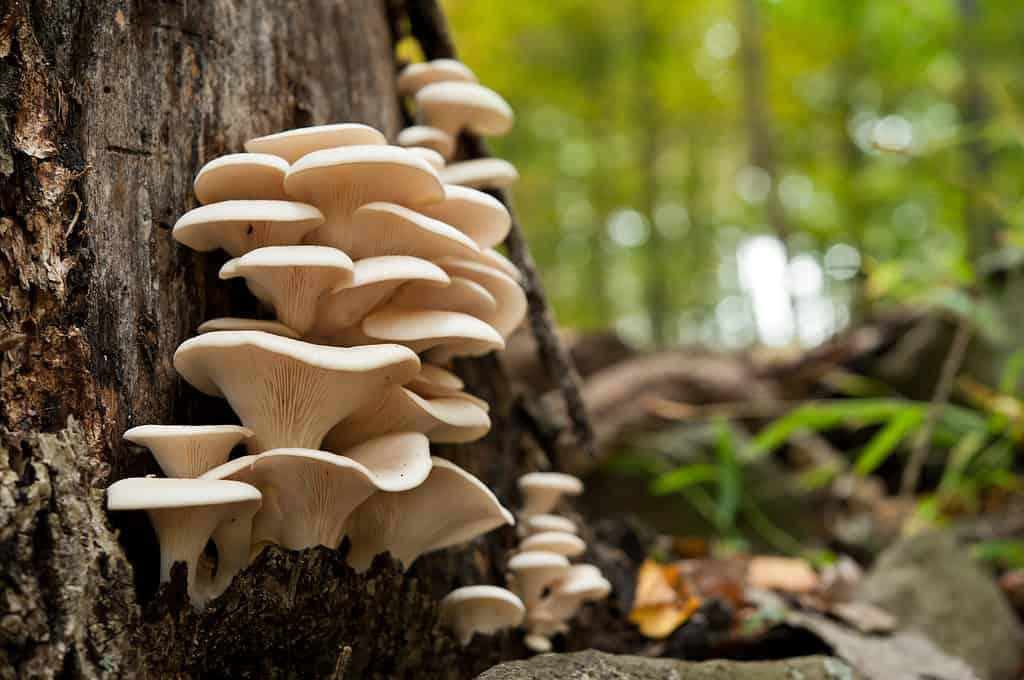
Oyster mushrooms grow on oak trees, fallen branches, dead stumps, and dying trees.
©iStock.com/lensblur
Named due to their resemblance to an oyster, these mushrooms assist in the decay of fallen trees. As a result, they give back to nature by providing nutrients for the soil used by other forest creatures. About 40 types exist and all are edible. Used in traditional medicine for centuries, they in fact possess health-promoting properties and many powerful compounds.
Where are They Found and How are They Identified?
Grown in many places, which include North America, they reside on oak trees, fallen branches, dead stumps, and dying trees, such as beech and maple. Their clusters resemble shelves and range in color from grey to white and brown in a flat fan shape, with a white or tan underside, and close-knit gills.
Primarily found during spring and fall, the most common types include:
- King trumpet
- Pearl oyster
- Pink oyster
- Golden oyster
What are the Health Benefits?
Loaded with minerals, vitamins, and fiber, oyster mushrooms are low in carbohydrates, and contain vitamin D, and selenium, as well as many other nutrients and antioxidants that reduce cellular damage. In addition, there is a reduction in disease risk factors such as high blood pressure and high cholesterol. Even more, they also help manage blood sugar levels and support the immune system. Research has shown that they prevent tumors, increase gut health, and hold anti-inflammatory properties.
Also, they contain:
- B vitamins, including niacin (B3) and riboflavin (B2)
- vitamin C
- potassium
- copper
- iron
- zinc
How to Use
Slightly sweet and mild with a great texture, they provide an excellent source of protein. As a result, add to soups, sauces, gravies, pasta dishes, sauteed with eggs, roasted, or grilled. Finally, they are a great vegetarian option, often used instead of meat.
Enoki Mushrooms (Flammulina filiformis)
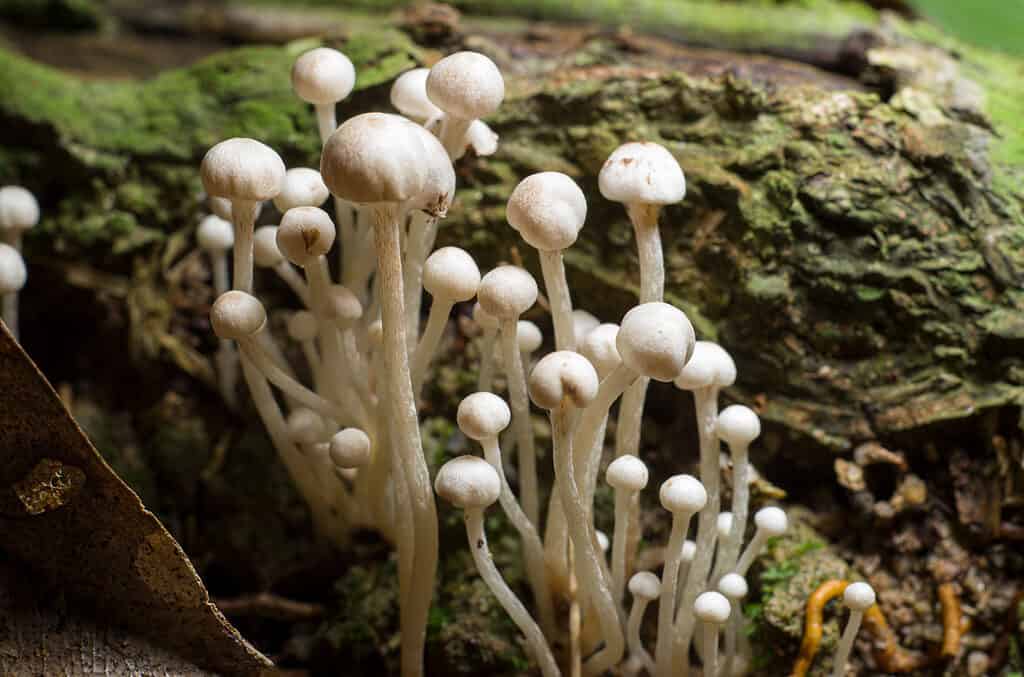
Enoki mushrooms are thin delicate mushrooms.
©iStock.com/Wirestock
Where are They Found and How are They Identified?
Enoki mushrooms grow in Asia, Europe, and North America. Additional names include golden needle, velvet shank, or winter mushrooms. These long, thin mushrooms are white with a small cap.
What are the Health Benefits?
These mushrooms are rich in nutrients, including vitamin B and fiber. In addition, high levels of niacin promote brain health and regulate cholesterol. Furthermore, they are rich in thiamine, which regulates nerve cell function.
A great source of antioxidants, they especially neutralize harmful free radicals protecting cells from oxidative stress and damage. For example, they prevent many chronic conditions, such as type 2 diabetes, cancer, and heart disease. Also, they contain immune-boosting properties.
How to Use
Delicate with a mild earthy flavor and crunchy texture, enjoy them raw in salads or cooked in soups and stir-fries.
Glistening Inkcap Mushrooms (Coprinellus Truncorum)
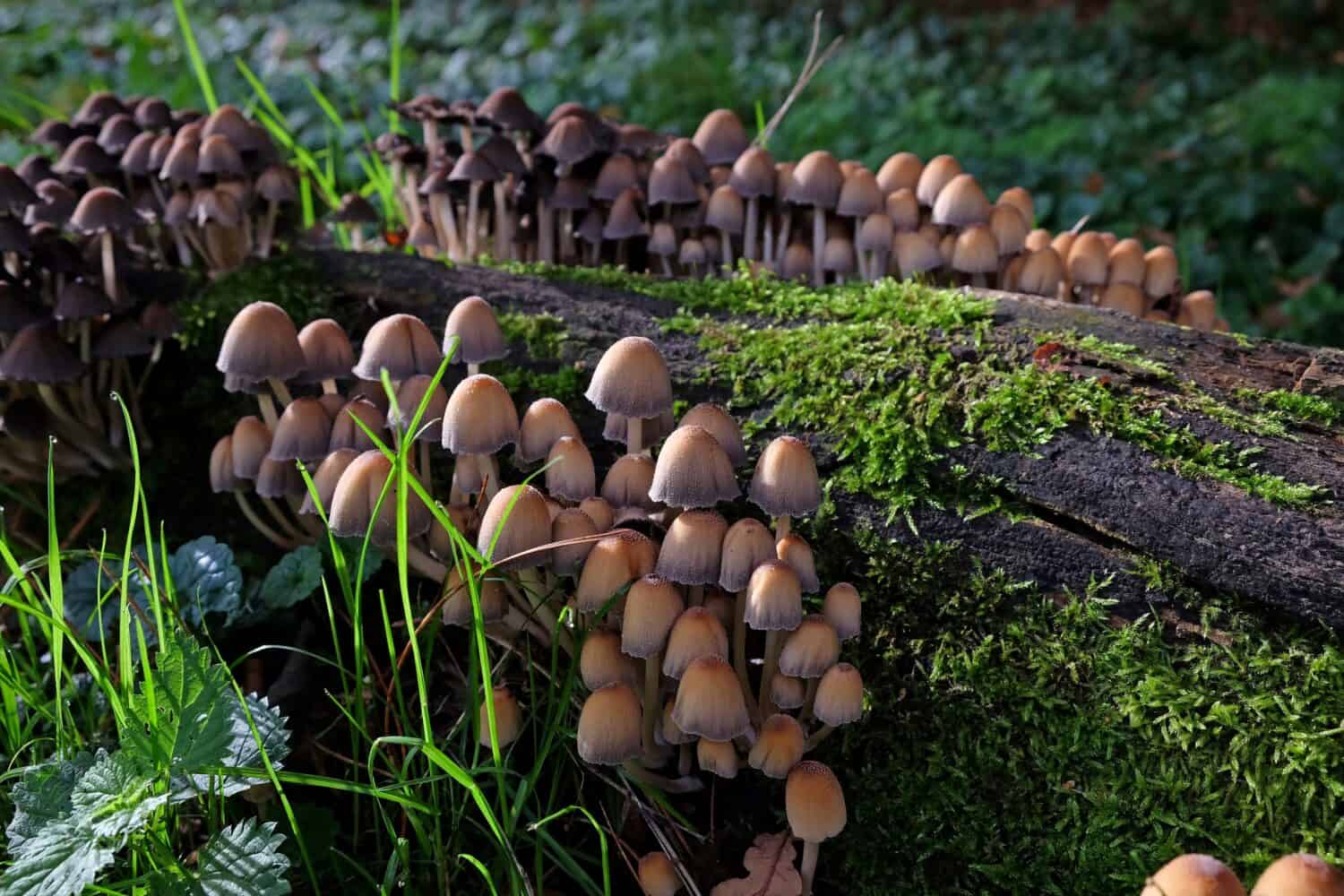
“Mica-like” flecks help identify glistening inkcap mushrooms.
©Alex Manders/Shutterstock.com
Belonging to the fungus family Coprinaceae, and also known as Mica Inkcap, this mushroom grows year-round except in winter. They have a brown cap with small white spots that disappear with age. Eventually, they turn gray-brown and the cap opens to a bell shape.
Where are They Found and How are They Identified?
Common in Ireland, Britain, Europe, Asia, South America, Australia, and North America, they grow on roots or dead wood in urban environments. Although edible, they can be poisonous if grown in polluted or roadside areas and are not a sought-after mushroom as they do not have a distinctive taste.
What are the Health Benefits?
They have no nutritional value.
How to Use
Enjoy mixed with other mushrooms as they have a mild taste. Avoid alcohol within 2-3 days before or after eating as you will become ill.
Hedgehog Mushrooms (Hydnum repandum)
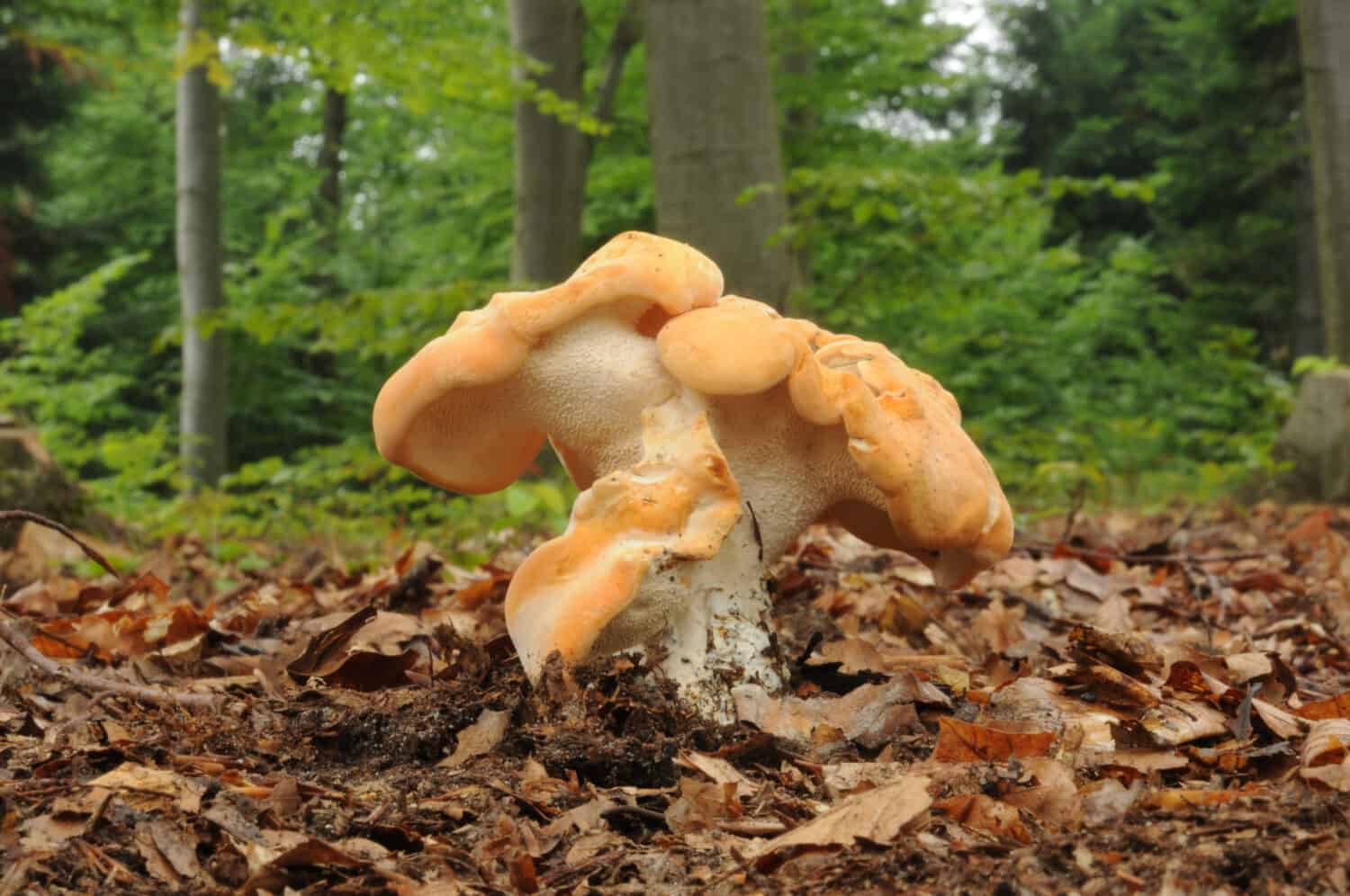
Hedgehog
mushrooms have a pleasant scent and a beautiful orange color.
©Tomasz Czadowski/Shutterstock.com
Also known as the sweet tooth mushroom or wood hedgehog, hedgehog mushrooms are a relative of the chanterelle. They smell similar but are larger and thicker in appearance.
Where are They Found and How are They Identified?
Irregular-shaped lobes can become 2-8 inches across, and grow around trees, such as beech or birch trees, during the fall months in parts of Asia, Europe, and North America.
What are the Health Benefits?
The hedgehog mushroom contains antibiofilm, antimicrobial, and anticancer properties. Furthermore, they are high in protein, a good source of B vitamins, and a variety of minerals.
How to Use
Eat them dried, fried, or sauteed, but eat them cooked. Delight in their earthy, nutty, sweet flavor grilled or sauteed.
Chicken of the Woods / The Sulfur Shelf (Laetiporus sulphureus)

Chicken of the woods has a meaty texture and is a great substitute for chicken.
©Marc Venema/Shutterstock.com
Large and yellow-orange in color, chicken of the woods mushrooms are hard to miss growing on rotting wood. They have white flesh with spores underneath and lack gills. Often used instead of chicken, they offer a meaty flavor.
Where are They Found and How are They Identified?
Found on hardwood trees in Europe and the United States, particularly the Rocky Mountains, they grow in dense shelf-like clusters during the summer and fall months
What are the Health Benefits?
Their health benefits include tumor prevention, antioxidant, and antifungal properties. In addition, they offer many nutrients such as:
- magnesium
- fiber
- potassium
- phosphorus
- vitamin C
- zinc
How to Use
They are delicious sautéed or added to egg or veggie dishes.
Honey Fungus (Desarmillaria caespitosa)
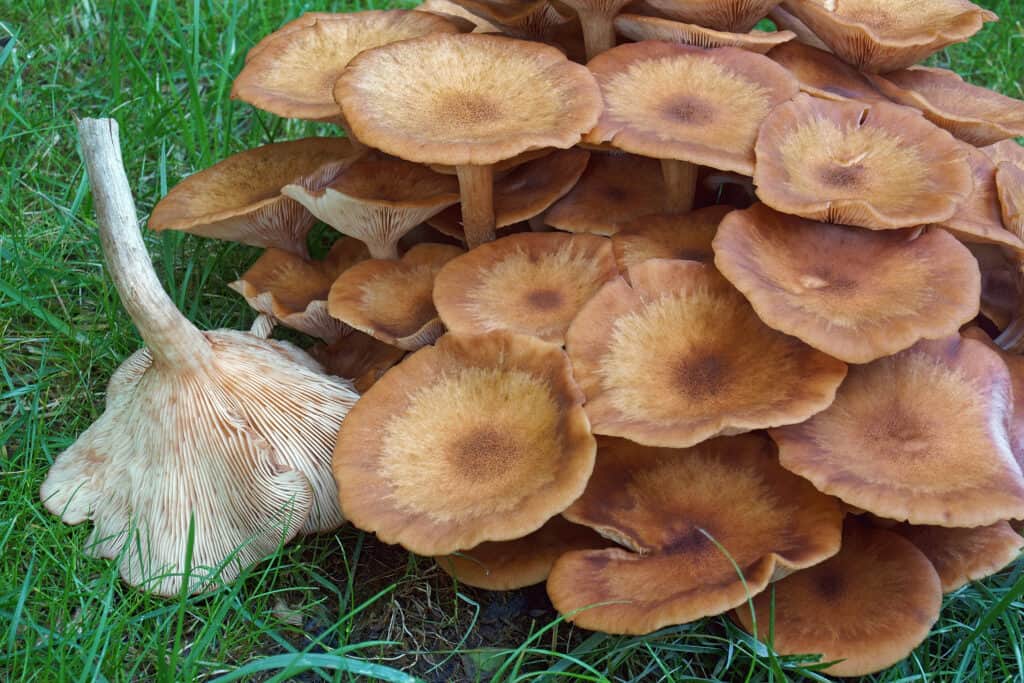
Honey fungus mushrooms provide food for small insects, which in turn become food for birds and other animals.
©iStock.com/nickkurzenko
Where are They Found and How are They Identified?
They are easily identified by their sweet odor and yellow flat or convex caps. Indigenous to the northern hemisphere, they specifically grow in Europe and North America year-round on dying, dead, or rotting trees. In addition, they grow on standing conifers or near wood chips.
What are the Health Benefits?
They are a great source of antioxidants.
How to Use
They are edible, but unsafe to eat raw. As a result, these fungi are best served as an addition to vegetables or meats but can cause side effects.
Shimeji Mushrooms (Hypsizygus tessellatus)
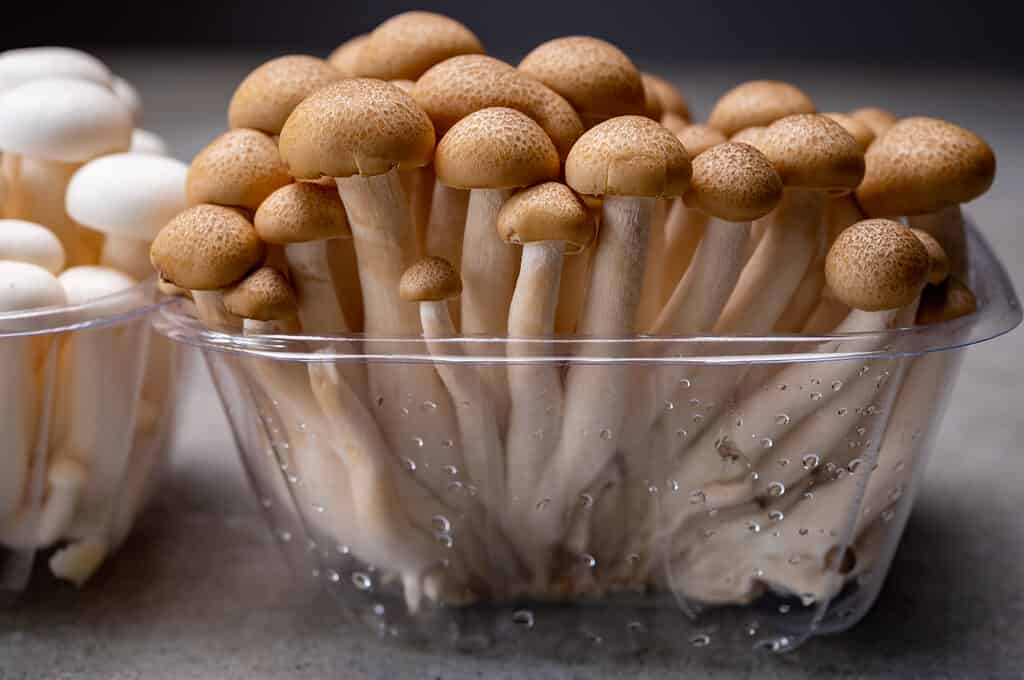
Shimeji mushrooms have a rich umami flavor.
©barmalini/Shutterstock.com
Also known as white beech mushrooms, Bunapi-shimeji, or white clamshell mushrooms, grow tightly packed on soil or wood, vary from light to dark brown in color, and are conical to flat-shaped with stipes.
Where are They Found and How are They Identified?
Native to East Asia, there are over 20 types.
What are the Health Benefits?
A great source of vitamin B-2, they are low in cholesterol and contain fiber.
How to Use
Enjoyed cooked, their taste is slightly nutty and sweet and is especially a popular ingredient in Japanese and Chinese dishes. Use in stew, soups, and stir-fries, as well as in wonton and dumplings.
Wood Blewit Mushrooms (Clitocybe nuda)

The wood blewit is a striking addition to the woodlands.
©Images01/Shutterstock.com
Where are They Found and How are They Identified?
Native to Europe and North America, they grow on logs of deciduous trees, sawdust, or rotted wood chips during the fall months. The purple cap is large and fleshy, measuring up to 6 inches across, smooth, with tightly-packed lilac gills that brown with age, and a thick stem tapering toward the cap. Their aroma specifically resembles that of an orange.
What are the Health Benefits?
They offer protein, and fiber, and are low in fat.
How to Use
Enjoy their strong and delicious flavor, especially in stews, sauteed, or in omelets. Avoid eating raw as there have been reports of allergies.
Black Trumpet Mushrooms (Craterellus cornucopioides)

Black trumpet mushrooms are also known as the trumpet of the dead.
©SariMe/Shutterstock.com
Where are They Found and How are They Identified?
Considered some of the tastiest black fungi in Europe and North America, their common names include black chanterelle in North America, trompette de la mort in France, Trombetta dei morti in Italy, and djondjon in Haiti. They have a funnel-like shape without gills, a black exterior, and are light gray underneath. Grown at the base of broadleaf trees, such as beech and oak trees, they grow during summer, fall, and winter in warmer areas.
What are the Health Benefits?
These are a great source of riboflavin, niacin, potassium, and B vitamins.
How to Use
Their rich, smoky, earthy flavor fairly resembles apricots. Popular uses include soups, sauces, and seafood recipes.
White Chanterelles (Cantharellus subalbidus)

White Chanterelles grow in old-growth forests.
©Viktoriia Kolosova/Shutterstock.com
Where are They Found and How are They Identified?
Commonly found in the Pacific Northwest in pine forests, this delicious mushroom is either cream or white in color with gills.
What are the Health Benefits?
They are rich in antioxidants and vitamin D.
How to Use
Specifically used for their delicate flavor, enjoy baked or sauteed in soups, sauces, and stews. When eaten raw, they have a peppery taste and a chewy, meaty texture.
Fried Chicken Mushrooms (Lyophyllum decastes)
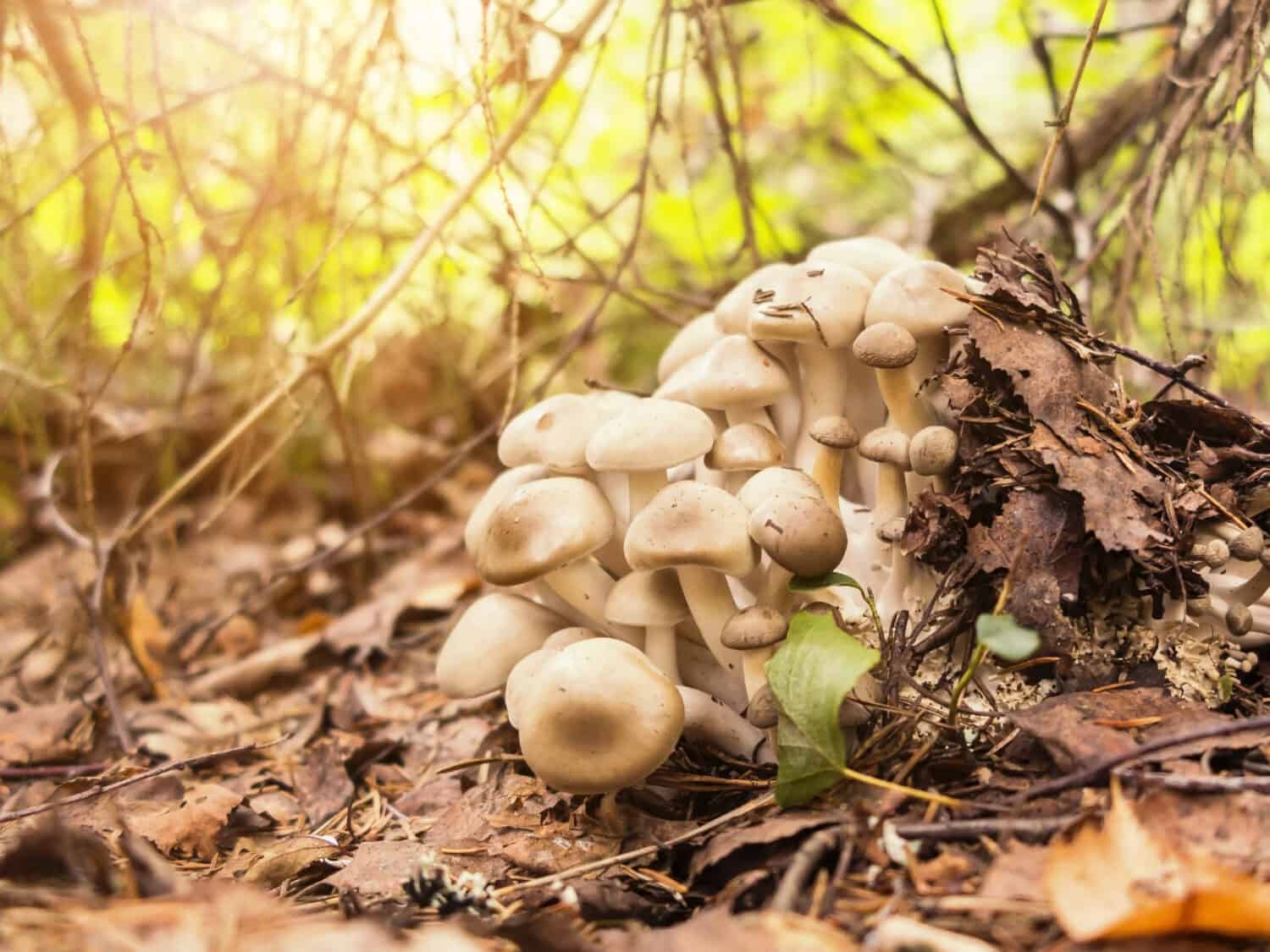
Fried chicken mushrooms taste as their name implies.
©galsand/Shutterstock.com
Where are They Found and How are They Identified?
They grow around the world, enjoyed for their meaty texture and flavor. They have a 2- to 5-inch cap, a color of whitish gray with white gills that yellow with age, and can grow up to 4 inches in height.
What are the Health Benefits?
They contain flavonoids, phenols, and polysaccharides.
How to Use
Excellent stir-fried or added to egg dishes, use the stems in soups and stews.
Yellowfoot Mushrooms (Craterellus tubaeformis)
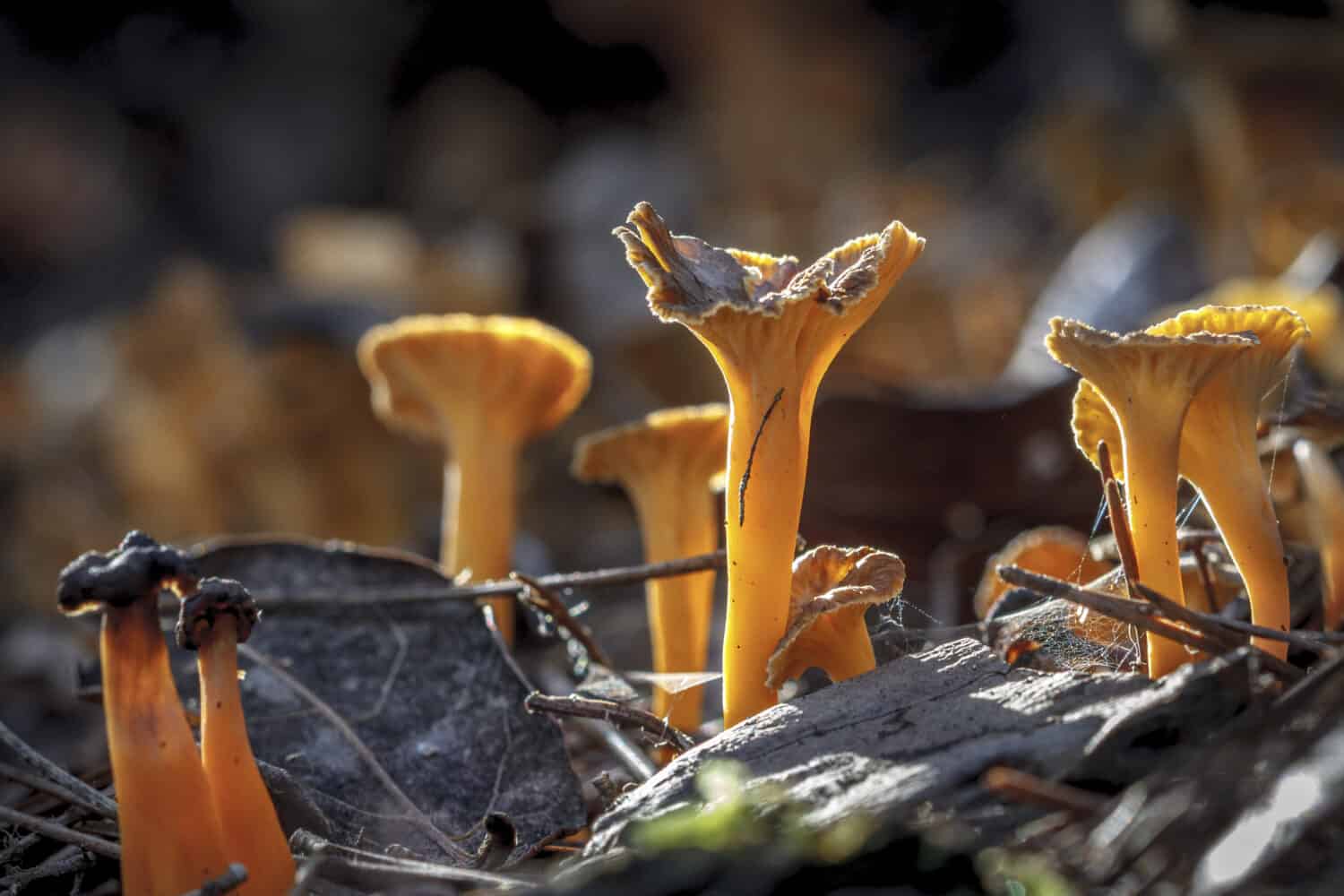
The yellowfoot chanterelle has a fruity aroma.
©Gonzalo Jara/Shutterstock.com
Hard to miss, this member of the Chanterelle family has a funnel-shaped cap and varies from bright orange to pale yellow in color depending on location.
Where are They Found and How are They Identified?
Indigenous to forests, they grow across the Pacific Northwest, Midwest, Mid-Atlantic, and Northeast United States, as well as northern Europe.
What are the Health Benefits?
They are rich in fiber, and polysaccharides, and provide inflammation reduction.
How to Use
Enjoyed especially in omelets, they have peppery notes and a sweet aroma like apricot.
Pheasant’s Back Mushrooms (Cerioporus squamosus)
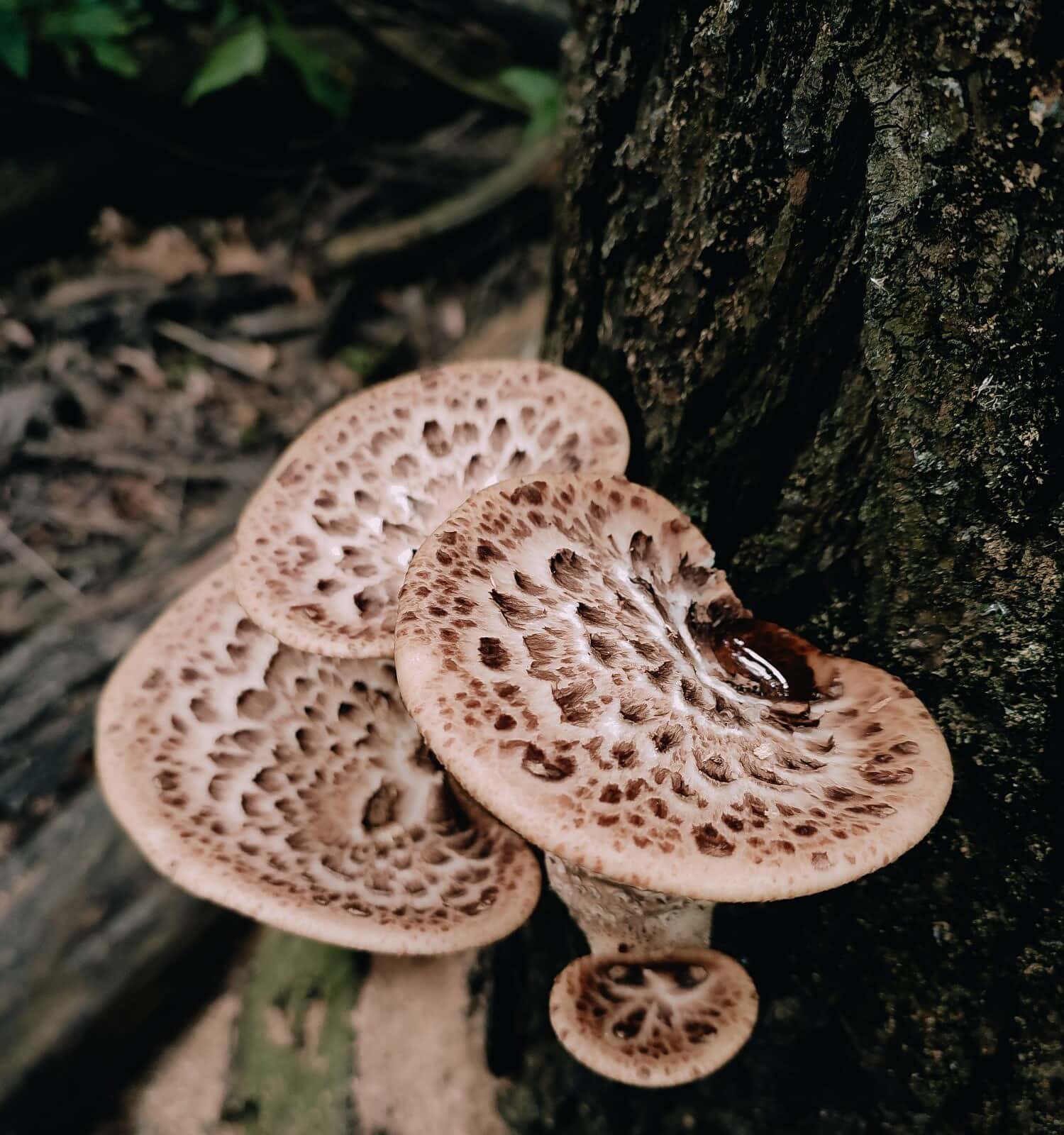
Pheasant’s back mushrooms have a beautiful pattern on their caps.
©SimonaZorina/Shutterstock.com
These mushrooms are also known as Dryads saddles from Greek mythology, in reference to the Dryads or tree nymphs who rode on them. They taste of fresh cucumber or watermelon rind and have an aroma of grain.
Where are They Found and How are They Identified?
Grown on live or dead trees, such as box elder or maple in overlapping tiers, they are indigenous to Australia, Europe, Asia, and North America. Colored like a pheasant’s feathers, they have funnel-shaped caps 3-12 inches across and 4 inches thick.
What are the Health Benefits?
A great source of protein, they contain vitamins D, C, and B complex, as well as essential minerals, such as selenium, copper, potassium, phosphorous, and iron. Additionally, they offer bioactive compounds to help regulate the immune system. That is, their anti-inflammatory and antibacterial properties inhibit the growth of bacteria. They prevent the formation of free radicals and contain a high antioxidant profile providing cancer-fighting properties and prevention of other illnesses.
How to Use
Delicious fresh or dried, they offer a great taste in stir-fries, soups or stews, roasted, or even made into jerky.
Pink-Tipped Coral Mushrooms (Ramaria botrytis)
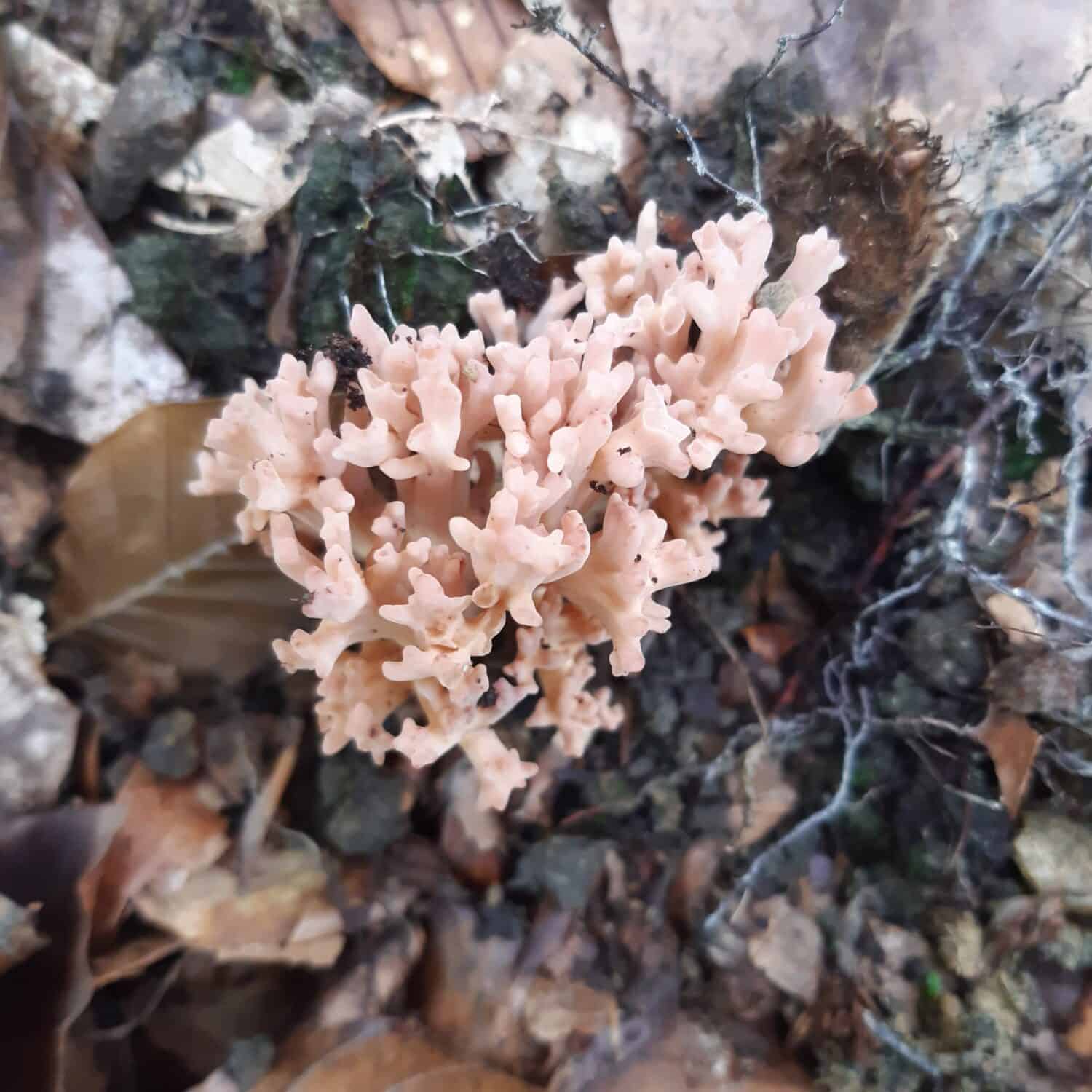
The pink-tipped coral mushroom resembles coral found in the sea.
©Olga S photography/Shutterstock.com
Where are They Found and How are They Identified?
Found in the United States, particularly in the Southeast in wooded areas, they are white with a bright pink tip and can range from 2-12 inches across. Additional names include the cauliflower coral or clustered coral mushroom.
What are the Health Benefits?
They are a good source of protein, calcium, potassium, magnesium, copper, essential amino acids, and antioxidants. Additionally, they possess antibacterial properties.
How to Use
They provide a delicious taste sauteed, in soups, and in egg dishes.
White Button Mushrooms (Agaricus bisporus)
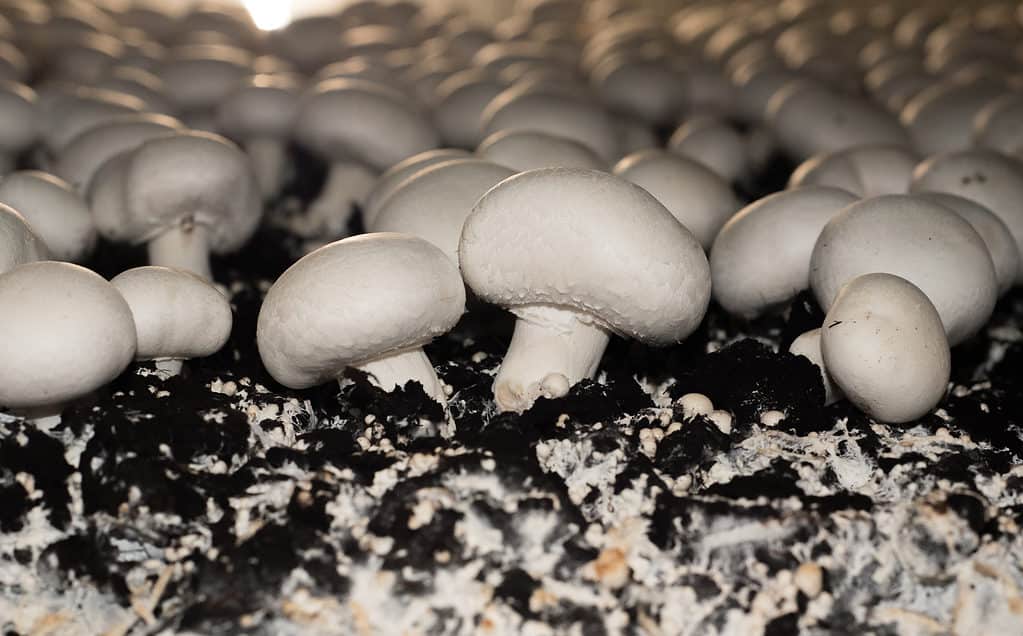
White button mushrooms are delicious in many dishes.
©ArliftAtoz2205/Shutterstock.com
Where are They Found and How are They Identified?
The white button mushroom is the most recognizable in the group. Available in white or brown, they are native to Eurasia and North America, as well as found in most grocery stores.
What are the Health Benefits?
They are nutrient-dense and high in protein, available in food and dietary supplements. Being low in calories, they additionally offer heart health and cancer-fighting properties. When young, they are referred to as white mushrooms, and as portobello mushrooms when fully grown. As a great source of vitamin D and B12, they help to control blood sugar levels, improve insulin resistance, and also act as a prebiotic for gut health.
How to Use
They are delicious raw, sauteed, stir-fried, scrambled with eggs, or roasted.
Shiitake Mushrooms (Lentinula edodes)
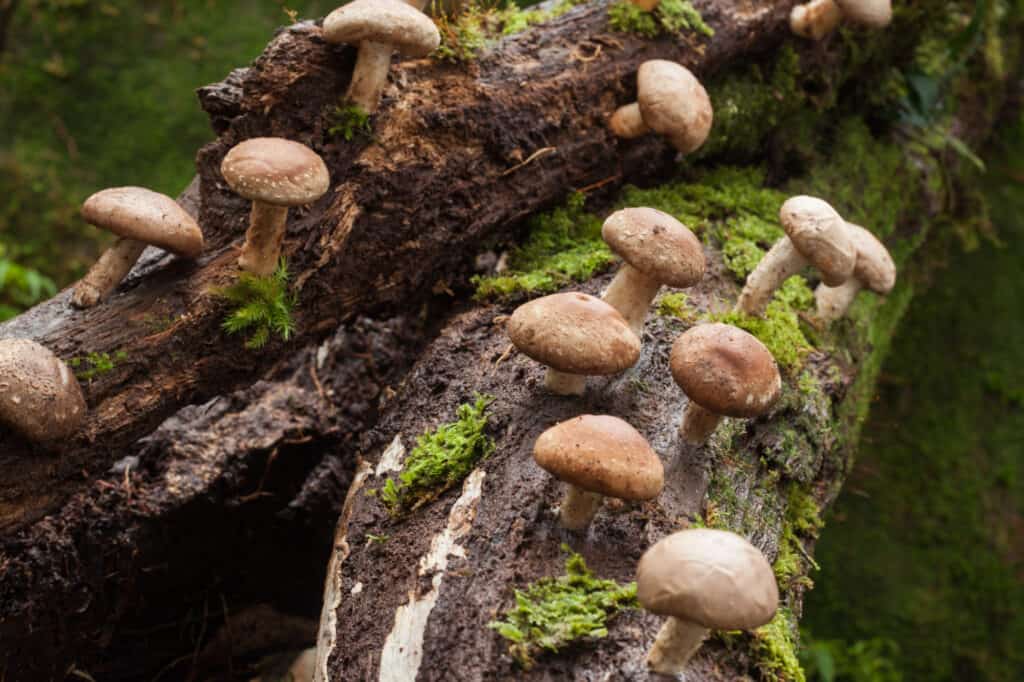
Shiitake mushrooms are delicious and very healthy.
©puttography/Shutterstock.com
Where are They Found and How are They Identified?
Native to East Asia, they are cultivated around the world and considered medicinal mushrooms. They contain lentinan, a polysaccharide used to boost the effects of medicines used for treating HIV and cancer. Ranging in color from tan to dark brown with 2- to 4-inch caps, they grow on decaying hardwoods, such as laurel oaks, maple, cherry, and hickory trees. In fact, around 83% come from Japan. They come as either dried, fresh, or in dietary supplements.
What are the Health Benefits?
This delicious mushroom is very healthy, high in fiber, and a good source of vitamins B and D, selenium, copper, and zinc. Additionally, it offers:
- immune system support
- improved brain function
- help with weight loss
They exist in traditional Chinese medicine, as well as in Japan, Eastern Russia, and Korea. The Chinese utilize them to boost longevity and energy, as well as improve circulation. Studies have found that their bioactive compounds protect against inflammation and cancer. Additionally, they contain 3 compounds (eritadenine, sterols, and beta-glucans), which boost heart health and aid in the reduction of cholesterol.
How to Use
Their distinct umami flavor is delicious sauteed, roasted, and in vegetarian dishes, stir-fries, and soup.
Morels (Morchella)
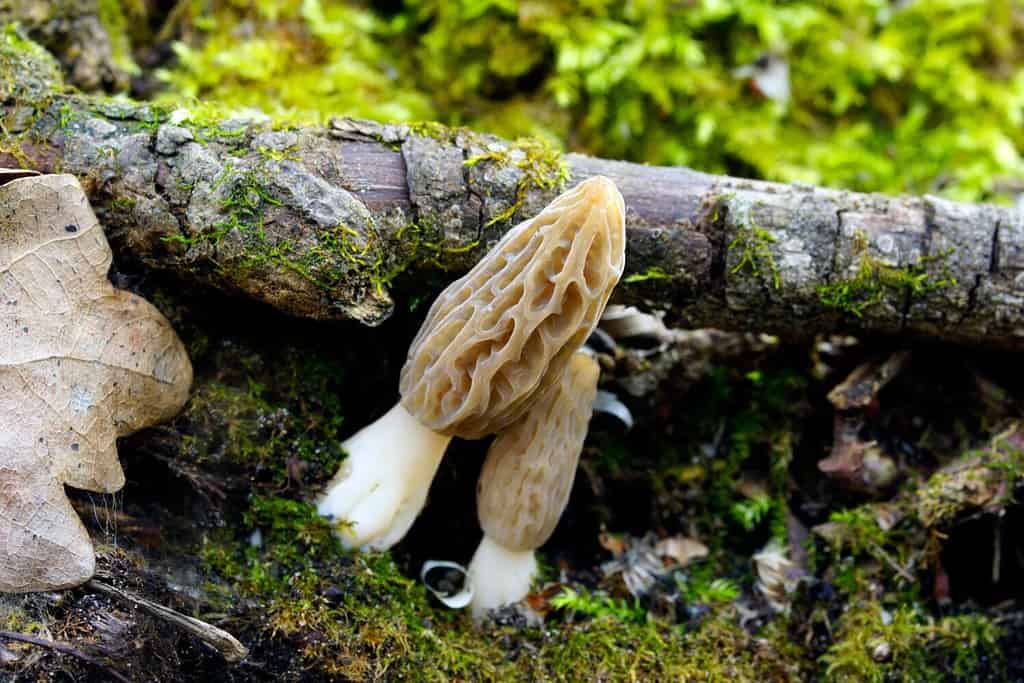
An unusual mushroom, morels are easy to identify.
©Rudenko Yevhen/Shutterstock.com
Where are They Found and How are They Identified?
These fungi belong to the order Pezizales and grow in South Africa, Australia, Asia, Europe, Canada, and mostly in the Midwest and Northeast United States. They grow around dying aspen, ash, elm, and oak trees. Their unique honeycomb appearance is due to their pitted caps.
What are the Health Benefits?
They contain antioxidants, and beta-glucans, and are anti-inflammatory.
How to Use
Their subtle nutty, woodsy, and earthy flavor make them perfect to sauté, add to pizza or fish dishes, or simply bread and fry. Darker types, especially, can taste smoky.
Puffball Mushrooms (Calvatia gigantea)
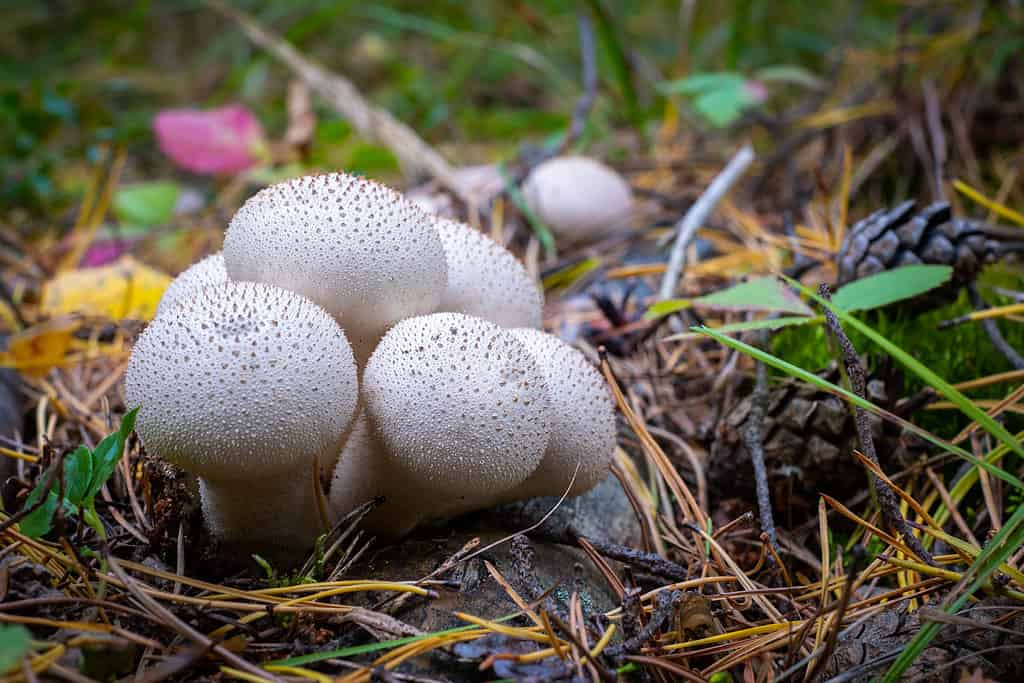
Puffball mushrooms look like
sea urchin
shells.
©Andrei Ksenzhuk/Shutterstock.com
Where are They Found and How are They Identified?
These huge mushrooms, commonly called giant puffballs, grow throughout Canada and the United States in deciduous forests, fields, and meadows during spring through fall, appearing after the rain and warm temperatures. They can grow as large as a watermelon and weigh 50-60 pounds. When young, they have a marshmallow-like texture. As they age, they turn powdery and break apart, releasing their spores.
Some say they have a mild flavor, while others say they are nutty, earthy, and rich in taste. They are often compared to tofu because of their versatility.
What are the Health Benefits?
They are a great source of potassium and antioxidants. Additionally, they have wound-healing and blood-clotting properties.
How to Use
Their solid white flesh pairs well with egg dishes, on burgers, or cooked with pasta.
Shaggy Mane Mushrooms (Coprinus comatus)
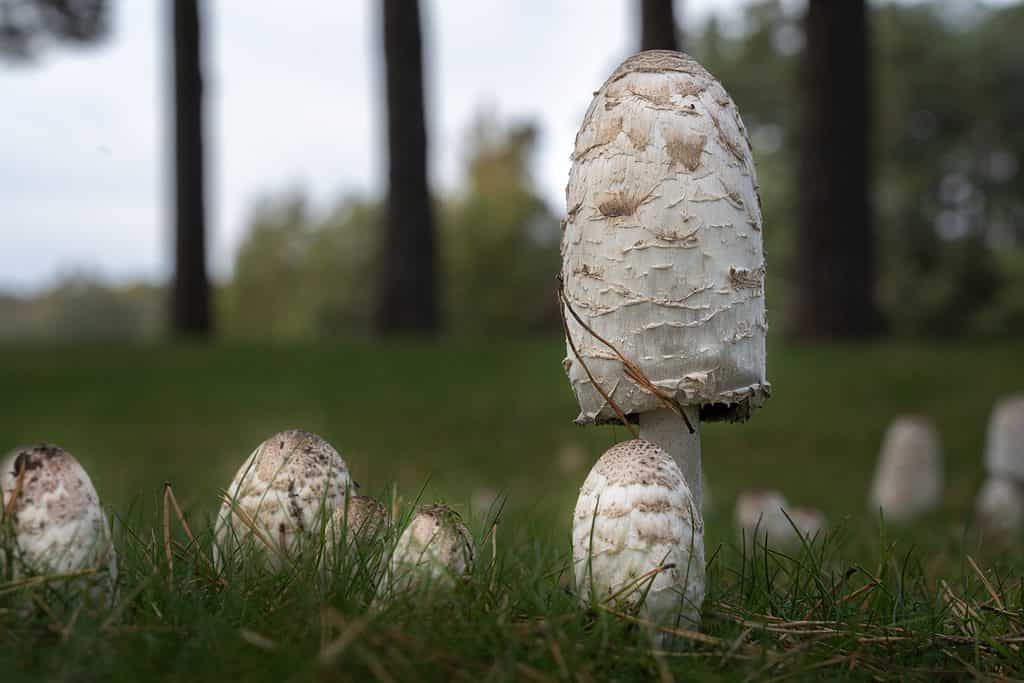
Shaggy Mane Mushrooms are easy to identify by their scaly caps.
©UKSTUDIO/Shutterstock.com
Where are They Found and How are They Identified?
Alternate names additionally include lawyer’s wig or inky cap due to their scaly, conical cap resembling a British barrister’s wig. They contain many beneficial properties and can grow from 2-6 inches in height. Found in garbage dumps, gravel roads, lawns, and parks, they reside in the desert regions of India, Australia, Mexico, and North America.
What are the Health Benefits?
They possess anticancer, antioxidant, and anti-inflammatory properties.
How to Use
Cook shortly after harvest and enjoy in stir-fries, soups, pasta, or burgers and steaks.
Lion’s Mane Mushrooms (Hericium erinaceus)
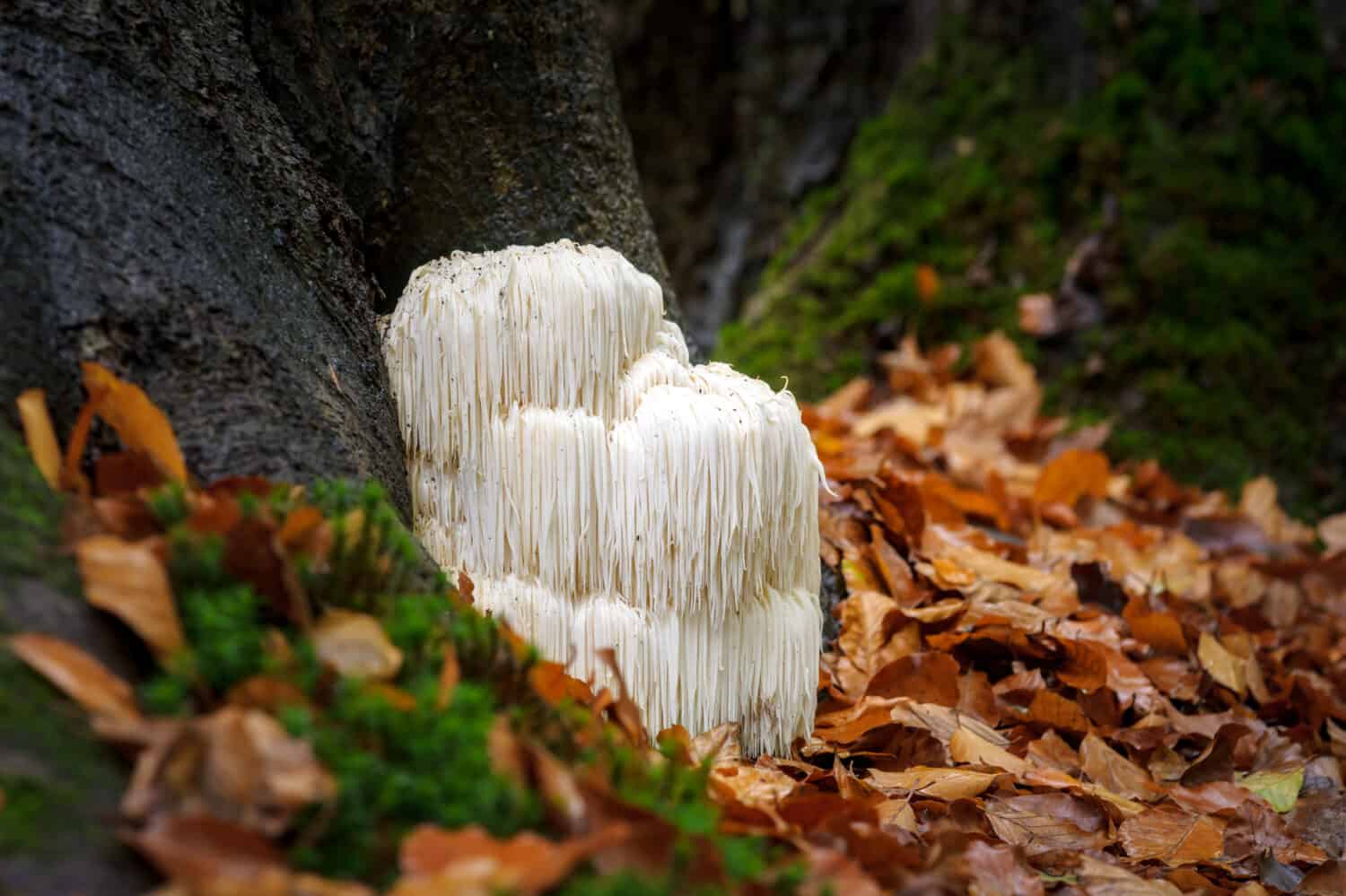
Easy to identify, the lion’s mane mushroom appears as their name suggests.
©Fotografiecor.nl/Shutterstock.com
Where are They Found and How are They Identified?
Belonging to the tooth fungus group, other names for them are bearded hedgehog, bearded tooth fungus, and mountain-priest mushroom. Native to Asia, Europe, and North America, they have long spines and grow on hardwoods, such as maple, beech, fallen oak, and dead or dying deciduous trees in single clumps of dangling spines.
What are the Health Benefits?
Lion’s Mane contains bioactive substances that benefit the gut, heart, and brain. Additionally, they possess a variety of health benefits, including being:
- antioxidative
- antimicrobial
- antihyperglycemic
- hypolipidemic
Studies have shown that they stimulate the growth of brain cells. Therefore, they offer protection against Alzheimer’s and Parkinson’s disease. They help with mild symptoms of anxiety and depression, speed nerve recovery in spinal cord and brain injuries, protect against ulcers, reduce the risk of heart disease, as well as help manage diabetes symptoms. In addition, they have cancer-fighting abilities, reduce inflammation, and boost the immune system.
How to Use
Steep as a tea, use dried, cooked, or eaten raw. They taste specifically like lobster or crab and are delicious in soups, pasta, or risotto. When in powder form, mix in a smoothie, coffee, or other hot drinks or foods.
Lobster Mushrooms (Hypomyces lactifluorum)
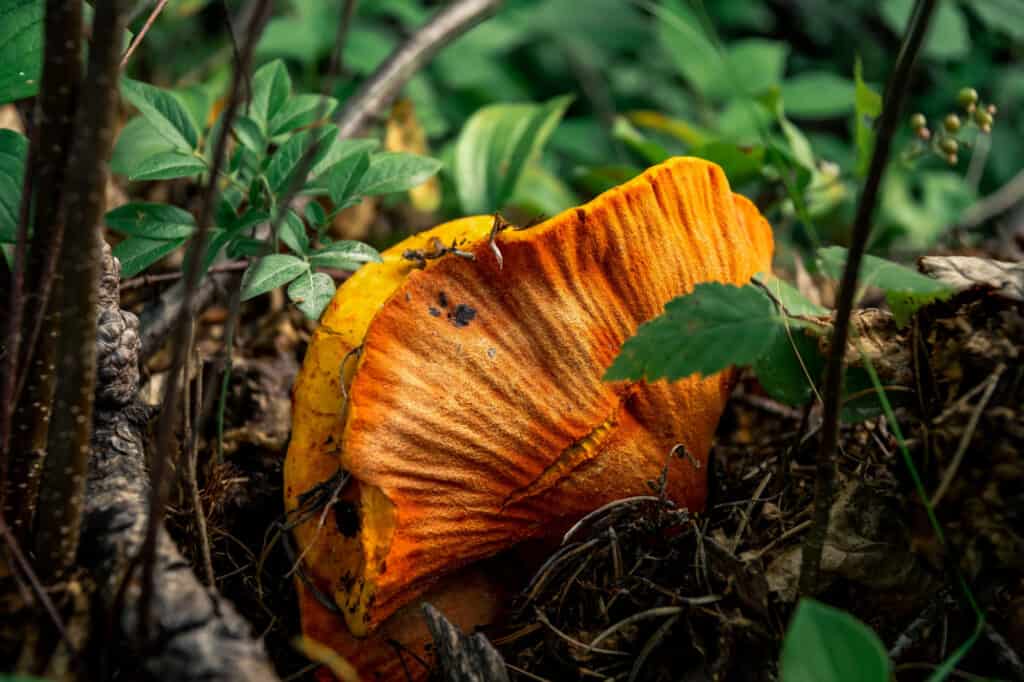
Lobster mushrooms have a gnarled appearance and stand out in the woods.
©Raphael Rivest/Shutterstock.com
Where are They Found and How are They Identified?
Found in Russia, Europe, and the Pacific Northwest of the United States, their vibrant orange flesh resembles cooked lobster. They have irregular-shaped caps and grow during the fall.
What are the Health Benefits?
Lobster mushrooms contain low amounts of vitamins K, D, and B, as well as a bit of fiber.
How to Use
Their meaty texture has a nutty, sweet aroma, enjoyed with dishes that call for white wine.
Bolete Mushrooms (Boletus edulis)

Bolete mushrooms are a favorite of humans and woodland creatures.
©Holger Krisp, CC BY 3.0 <https://creativecommons.org/licenses/by/3.0>, via Wikimedia Commons – Original / License
Where are They Found and How are They Identified?
Grown in Asia, Europe, and North America, bolete mushrooms consist of a tan-colored cap without gills and a thick stem. Edible or poisonous, they thrive under specific trees, such as madrone, birch, and aspen, forming a symbiotic relationship with them. Accordingly, check a mushroom guide for information to ensure the correct species.
What are the Health Benefits?
Their health benefits include:
- antioxidants
- anticancer properties
- constipation prevention
- liver protection
- antimicrobials
- blood pressure control
How to Use
Harvest when young, enjoy pickled, dried, or fresh. Delight in their umami flavor sauteed with fish or meats.
| Mushroom Name | Where Found |
|---|---|
| Maitake Mushrooms or Hen of the Woods | North America, China, and Japan |
| Oyster Mushrooms | Grown in many places, including North America |
| Enoki Mushrooms | Asia, Europe, and North America |
| Glistening Inkcap Mushrooms | Ireland, Britain, Europe, Asia, South America, Australia, and North America |
| Hedgehog Mushrooms | Asia, Europe, and North America |
| Chicken of the Woods / The Sulfur Shelf | Europe and the United States, particularly in the Rocky Mountains |
| Honey Fungus | Europe and North America |
| Shimeji Mushrooms | East Asia |
| Wood Blewit Mushrooms | Europe and North America |
| Black Trumpet Mushrooms | Europe and North America |
| White Chanterelles | Pacific Northwest of the United States |
| Fried Chicken Mushrooms | They are found around the world |
| Yellowfoot Mushrooms | Pacific Northwest, Midwest, Mid-Atlantic, and Northeast United States, Northern Europe |
| Pheasant’s Back Mushrooms | Australia, Europe, Asia, and North America |
| Pink-Tipped Coral Mushrooms | United States, particularly the Southeast |
| White Button Mushrooms | Eurasia and North America |
| Shiitake Mushrooms | East Asia |
| Morels | South Africa, Australia, Asia, Europe, Canada, and mostly Midwest and Northeast United States |
| Puffball Mushrooms | Canada, United States |
| Shaggy Mane Mushrooms | India, Australia, Mexico, and North America |
| Lion’s Mane Mushrooms | Asia, Europe, and North America |
| Lobster Mushrooms | Russia, Europe, Pacific Northwest of the United States |
| Bolete Mushrooms | Asia, Europe, and North America |
The information presented on or through the Website is made available solely for general informational purposes. We do not warrant the accuracy, completeness, or usefulness of this information. Any reliance you place on such information is strictly at your own risk. We disclaim all liability and responsibility arising from any reliance placed on such materials by you or any other visitor to the Website, or by anyone who may be informed of any of its contents. None of the statements or claims on the Website should be taken as medical advice, health advice, or as confirmation that a plant, fungus, or other item is safe for consumption or will provide any health benefits. Anyone considering the health benefits of particular plant, fungus, or other item should first consult with a doctor or other medical professional. The statements made within this Website have not been evaluated by the Food and Drug Administration. These statements are not intended to diagnose, treat, cure or prevent any disease.
Thank you for reading! Have some feedback for us? Contact the AZ Animals editorial team.








